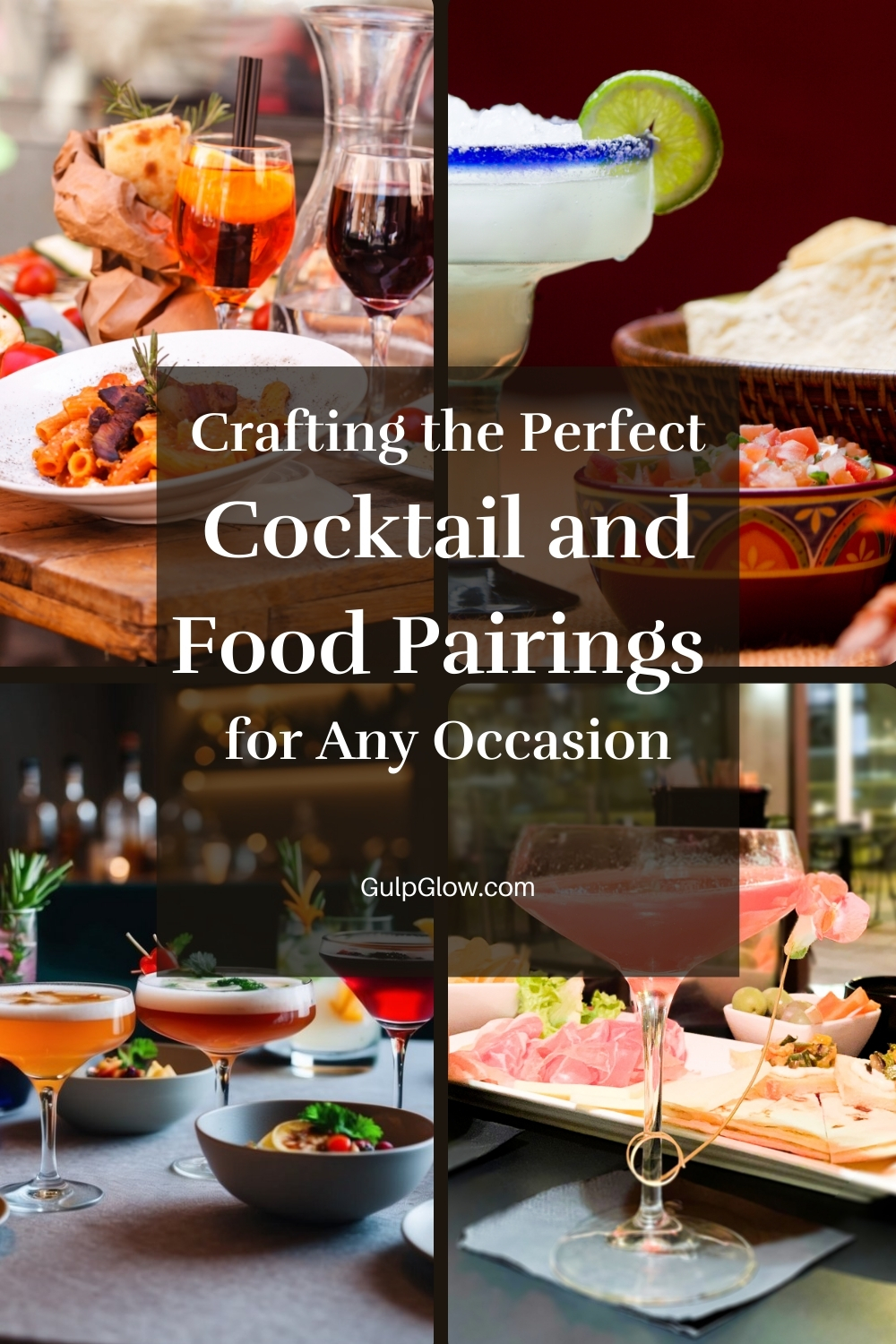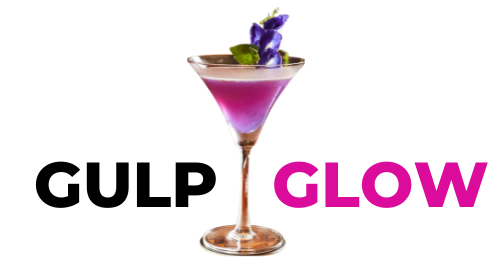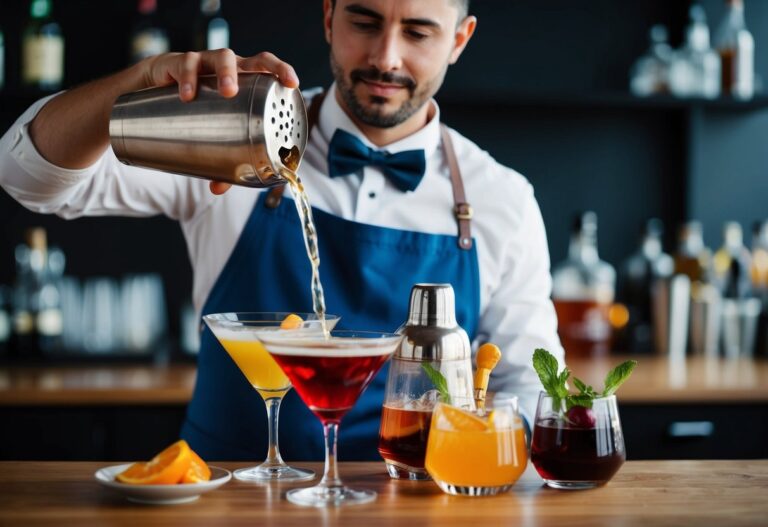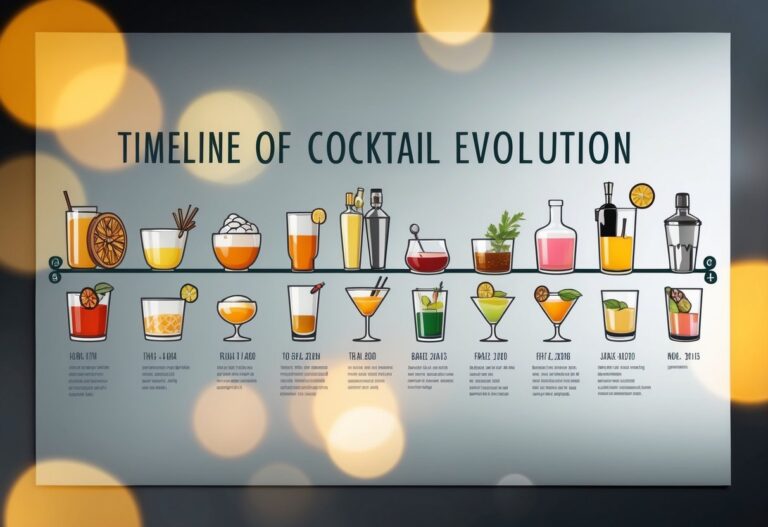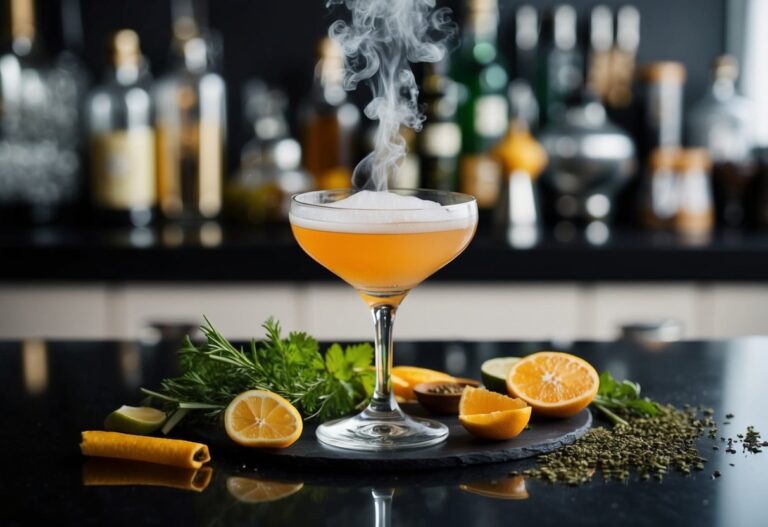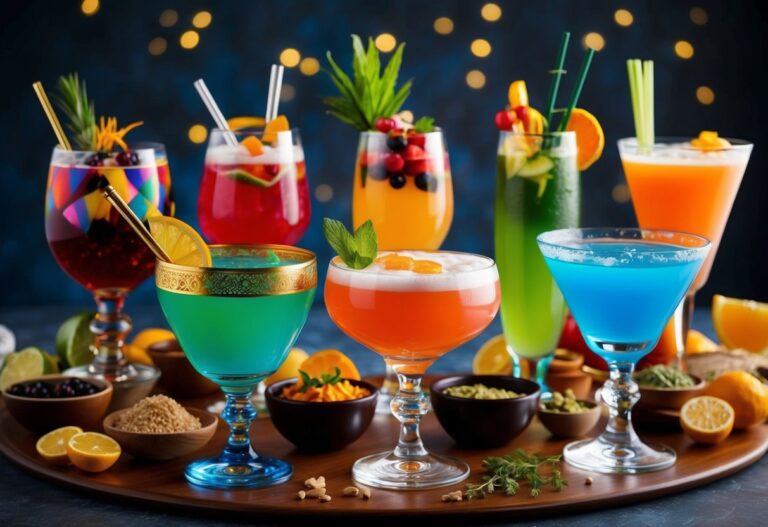Pairing Cocktails with Food: Elevate Your Dining Experience
Pairing cocktails with food can elevate your dining experience. By focusing on the harmony of flavors, you can create combinations that make both the drink and the dish taste better. The key is to balance the weight, intensity, and character of both the cocktail and the food.

Imagine enjoying a light, citrusy cocktail with a fresh seafood dish. The acidity and brightness of the drink can enhance the flavors of the seafood, making every bite and sip more enjoyable. On the other hand, a bold, aged whiskey cocktail can perfectly complement a rich, chocolate dessert, creating an unforgettable contrast.
When you match cocktails and food, think about how elements like acidity, sweetness, bitterness, and alcohol content work together. An acidic drink pairs wonderfully with fatty foods, cutting through the richness and cleaning your palate. Experiment with pairings like a smoky bourbon with spicy barbecue, or a refreshing Mimosa with a fruity dessert, and discover a new dimension of dining pleasure.
The Basics of Cocktail Pairing
Pairing cocktails with food can elevate your dining experience. The two main principles are understanding flavor profiles and balancing the intensity and weight of both the cocktail and dish.
Understanding Flavor Profiles
Flavor profiles are the combination of tastes that define a dish or drink. Common profiles include sweet, salty, sour, bitter, and umami. Know these to pair effectively.
Example: Sweet and savory often go well together, like a Margarita with spicy tacos. The tangy lime juice cuts through the spice, creating a refreshing balance.
Another tip: Avoid too similar flavors, as they may clash. Instead, seek complementarity. For instance, pair a fruity cocktail with a rich, creamy dessert to highlight contrasting elements.
Balancing Intensity and Weight
Balance the intensity and weight of both food and drink. A light cocktail may be overpowered by a heavy, rich dish. Think about the strength and texture of both components.
For example:
- Light cocktails like a Gin and Tonic pair well with lighter dishes like salads or seafood.
- Heavy cocktails like a Bourbon Old Fashioned match better with robust dishes like steak or rich desserts.
Simple rule: Light with light, heavy with heavy. This way, neither overpowers the other, letting both the food and drink shine.
Pairing Techniques
When pairing cocktails with food, two primary methods stand out: complementing flavors and contrasting pairings. Each approach enhances the dining experience in its own way, creating a harmonious or exciting balance on your palate.
Complementing Flavors
Complementing flavors involve matching similar tastes and aromas in both the drink and the dish. For instance, a citrusy cocktail might pair well with a seafood dish that has lemon notes. This method enhances harmony between the food and drink, making flavors more prominent.
Key tips include:
- Identify Dominant Flavors: Pinpoint the key flavors in the dish.
- Match Aromas and Tastes: Choose cocktails that share these flavors.
- Consider Texture: A creamy cocktail can enhance a creamy dish.
Examples:
- A margarita with fish tacos.
- Gin and tonic with herbed chicken.
Contrasting Pairings
Contrasting pairings focus on differences to create an exciting and balanced dining experience. A spicy dish may be paired with a sweet cocktail to balance the heat, for example.
Consider these strategies:
- Balance Intensity: Pair a rich dish with a light, refreshing drink.
- Opposing Flavors: Sweet cocktails can tame spicy foods.
- Enhanced Experience: These contrasts can make each element more memorable.
Examples:
- Spicy margarita with sweet and sour pork.
- Dark rum with charred barbecue ribs.
Selecting Spirits

When pairing cocktails with food, it’s important to match the spirit’s intensity, flavor profile, and texture with the dish. Here, we’ll look at key spirits and how to select them for the best pairings.
Classics: Gin, Whiskey, and Rum
Gin: Known for its herbal, botanical notes, gin pairs wonderfully with light dishes like seafood or salads. Try a gin and tonic with grilled shrimp or a gin martini with a citrusy salad.
Whiskey: This versatile spirit comes in many varieties. A smoky Scotch or bourbon can enhance the flavors of a rich, grilled steak. For a spicier rye whiskey, think roasted or spiced foods like barbeque ribs.
Rum: With its caramel and tropical flavors, rum can be light or dark. Light rum is great with chicken or pork dishes. Dark rum, with its deeper flavors, pairs well with rich desserts or hearty dishes like jerk chicken.
Exploring Vodka, Tequila, and Cognac
Vodka: This neutral spirit is extremely versatile. Pair a vodka gimlet with a fresh salad or use a vodka tonic to complement delicate fish dishes. The simplicity of vodka allows it to blend well with a variety of flavors.
Tequila: Known for its strong, earthy taste, tequila can be a bit tricky. Light tequila, like a blanco, pairs well with citrusy dishes or fresh salsas. Darker tequilas, such as reposado, are perfect for heartier fare like grilled meats or spicy foods.
Cognac: With its rich, complex flavors, cognac is ideal for pairing with desserts or deeply flavored dishes. Enjoy a glass of cognac with chocolate cake or a rich stew. The depth of cognac can bring out the best in luxurious dishes and sweet treats.
Food-Cocktail Fusion

Pairing cocktails with food is an art form that can elevate your dining experience. In this section, we explore how different cuisines and specific dishes can be complemented perfectly with the right cocktails.
Pairing with Different Cuisines
Italian Cuisine When thinking about Italian food, it’s hard to ignore classics like pizza and pasta. Light and refreshing cocktails, like a Negroni or a sparkling Italian soda, can enhance the flavors of a margherita pizza or a creamy Alfredo pasta.
Mexican Food Mexican dishes often have bold, spicy flavors. You can’t go wrong with a Margarita or a Paloma. These cocktails bring out the heat in dishes like tacos and enchiladas while adding a refreshing citrus kick.
Asian Cuisine Asian cuisine is diverse, covering everything from sushi to spicy Thai dishes. For sushi, try a sake cocktail or a light gin and tonic. For Thai or other spicy dishes, a cooling coconut mojito or a citrusy gimlet can balance the heat.
Specific Dish Pairings
Grilled Steak and Bourbon A grilled steak pairs excellently with a bourbon-based cocktail. Bourbon’s smoky and sweet notes complement the umami flavors of a well-cooked steak.
Grilled Chicken and Citrus Drinks Grilled chicken works well with lighter, citrusy drinks. A lemony gin cocktail or a mojito will add a refreshing element to the dish.
Seafood and Light Cocktails Seafood dishes, especially lighter ones like fish or shrimp, pair wonderfully with subtle, refreshing cocktails. A gin and tonic or a light vodka cocktail will enhance the freshness of the seafood without overpowering it.
Desserts For dessert, consider tiramisu with a coffee liqueur cocktail. The flavors meld together beautifully, and the coffee notes in both the dessert and the drink create a harmonious ending to your meal.
Cocktail Recipes for Every Occasion

Everyone has their favorite cocktail, but the best choice often depends on the time of year and the occasion. Let’s explore refreshing cocktails perfect for summer and cozy drinks to warm you up in winter.
Refreshing Summer Cocktails
When it’s hot out, you crave something light and refreshing. Mojitos are a popular choice with their mix of white rum, fresh mint, lime juice, sugar, soda water, and ice. They’re easy to make and perfect for a sunny day.
Another summer favorite is the Margarita. This classic combines tequila, lime juice, and triple sec. Serve it on the rocks or blended with ice for a frozen treat. Add a salted rim to balance the tangy flavors.
Negronis are ideal for those who enjoy a slightly bitter drink. Mix equal parts gin, Campari, and sweet vermouth over ice and garnish with an orange peel.
Bloody Marys are excellent for brunch. This savory cocktail blends vodka, tomato juice, and various spices and seasonings. Customize it with celery, olives, or even bacon.
Cozy Winter Warmers
Winter calls for drinks that feel like a warm hug. Old Fashioneds are a classic option. Combine bourbon or rye whiskey, a sugar cube, a few dashes of bitters, and a twist of orange peel.
For something comforting, try a Manhattan. Mix rye whiskey or bourbon, sweet vermouth, and a few dashes of bitters. Serve it up or on the rocks with a cherry garnish.
Hot cocktails are also perfect in winter. Warm up with a Hot Toddy by combining whiskey, honey, lemon, and hot water. Add a cinnamon stick for an extra touch of warmth.
Another winter favorite is the Hot Buttered Rum. Mix butter, brown sugar, cinnamon, nutmeg, and cloves with hot water and a shot of rum. This rich and creamy drink is sure to keep the chill away.
Textures and Aromas

When pairing cocktails with food, paying attention to the textures and aromas can significantly enhance your dining experience. The way a drink feels in your mouth and the scent it carries can either complement or contrast with your dish, creating a balanced and enjoyable meal.
Mouthfeel and Alcohol Content
The mouthfeel of a cocktail can greatly impact how it pairs with food. Drinks that are light and bubbly, like a gin and tonic, can be refreshing and cleanse your palate. On the other hand, creamy cocktails like a White Russian can provide a rich, satisfying texture.
Consider the alcohol content too. High-alcohol drinks can be overwhelming if paired with delicate dishes. A light, fruity cocktail might be a better match for a fresh salad, while a robust whiskey might work well with a hearty steak.
Tip: Pairing a high-alcohol drink with spicy food can enhance the heat, while a creamy drink can mellow it out.
Aromas and Bitterness
Aromas play a key role in the flavor experience. A drink with herbal notes, like a mojito, can bring out the fresh flavors in a dish with similar herbs. Alternatively, a cocktail with floral scents can add complexity to a simple dish.
Bitterness is another element to consider. A bitter cocktail like a Negroni can balance out the sweetness of a dessert, or it can complement the savory flavors of a salty snack.
Pro Tip: When you smell your drink before tasting it, you’re engaging your senses fully, which enhances the overall dining experience.
The Art of Mixology

Mixology isn’t just about mixing drinks; it’s a blend of creativity, science, and skill. Knowing the right tools and techniques, and understanding the importance of glassware, can elevate your cocktail game tremendously.
Tools and Techniques
In the world of mixology, having the right tools is a game-changer. Essentials include a shaker, a jigger for measuring, a muddler for crushing ingredients, a strainer, and a bar spoon. Each tool has its own purpose and makes the preparation process smoother and more precise.
Shaking and stirring are two primary techniques in mixology. Shaking is ideal for cocktails with fruit juices, cream, or egg whites, as it helps blend and aerate the ingredients. On the other hand, stirring is used for cocktails containing only spirits, as it retains the clarity and texture of the drink.
When shaking a cocktail, fill your shaker halfway with ice, add the ingredients, and shake for about 15 seconds until the outside feels cold. For stirring, simply fill a mixing glass with ice and use the bar spoon to stir gently for around 20 seconds.
The Role of Glassware
Choosing the right glass is just as vital as mixing the right ingredients. The type of glass you use can affect the taste, aroma, and presentation of your drink. For example, a martini is served in a martini glass to keep it chilled but not watered down.
Lowball glasses are great for serving cocktails like Old Fashioneds, while highball glasses are perfect for tall, refreshing drinks like Mojitos. Each glass shape isn’t just for looks; it also enhances the flavor and aroma of the cocktail.
Remember that temperature matters. Always use chilled glasses for cocktails served cold and room temperature glasses for warm drinks. Proper glassware can make your cocktail experience both sophisticated and enjoyable.
Pairings for Desserts and Cheeses

Pairing desserts and cheeses with the right cocktails can take your taste experience to the next level. Read on to find out how to pair your favorite sweets and cheeses with the perfect drinks.
Dessert Cocktails
When it comes to desserts, choosing a cocktail that complements the sweetness while balancing flavors is key. For chocolate-based desserts, a Dark and Stormy can work wonders. The spice of ginger beer and the richness of dark rum elevate the bitter notes of dark chocolate.
For a lighter option, consider Lemon Bars with a French 75. The bubbles and hint of lemon in the cocktail perfectly match the zesty flavors of the bars, creating a refreshing palate cleanser.
If you’re a fan of caramel desserts, a Salted Caramel Martini can add another layer of flavor. The notes of vodka and caramel liqueur blend seamlessly, enhancing the sweet and salty dynamics.
Cheese and Charcuterie Accompaniments
Pairing cheese, especially aged varieties like Gouda, with cocktails can be an intriguing experience. Aged Gouda goes well with a Whiskey Sour. The nutty flavors of the cheese mesh beautifully with the rich, spicy notes of whiskey.
For a cheese and meat platter, consider a classic Manhattan. This drink’s smooth, balanced flavor pairs excellently with a mix of savory charcuterie and creamy cheeses, like Brie.
Using sharper cheeses like Blue Cheese? Try a Gin and Tonic. This cocktail’s botanical notes lighten the strong flavors of the cheese, providing a harmonious contrast.
Adventurous Pairings

Who says you can’t mix things up with your cocktails and food? By stepping out of your comfort zone, you can create unforgettable dining experiences that thrill your taste buds. Ready to go on a culinary adventure?
Experimental Combinations
Experimenting with cocktails and food can be immensely rewarding. Have you ever thought of pairing a smoky mezcal with dark chocolate? The smokiness of the mezcal complements the rich bitterness of high-quality dark chocolate, giving a new twist to dessert time.
Another interesting pairing is a spicy margarita with sweet, grilled pineapple. The chili heat from the margarita contrasts beautifully with the caramelized sweetness of the pineapple, making each bite and sip a tantalizing experience. When you’re feeling particularly adventurous, try curry dishes with peppery gin; the heat of the curry and the herbaceous notes of the gin can create a symphony of flavors in your mouth.
Don’t hesitate to mix and match desserts with cocktails either. For a fun experience, pair a sweet cocktail like a Piña Colada with salty snacks such as nuts or pretzels. The salty and sweet combo is a guaranteed palate pleaser!
Themed Food and Cocktail Evenings
Imagine hosting a night where every dish and drink align with a specific theme. For instance, a tropical-themed evening could include dishes like coconut shrimp paired with a classic Mai Tai or pineapple fried rice paired with a refreshing Mojito. Creating such themes can make your dining experience more cohesive and enjoyable.
A retro theme can be equally exciting. Think of pairing a 1950s-style milkshake cocktail with a classic American burger and fries. It not only creates a nostalgic setting but also delivers layers of flavors that transport you back in time.
Another idea could be an around-the-world theme. Start in Mexico with tacos and a bold Margarita, then move to Italy with bruschetta and an Aperol Spritz, and finally, finish off in France with a delicate croissant and a Champagne cocktail. These thematic voyages can make your meal feel like a global adventure without leaving your home.
Frequently Asked Questions
Pairing cocktails with food can be an amazing way to enhance your dining experience. From matching acidity to balancing flavors, here are some specific tips for getting the most out of your pairings.
What are some perfect appetizer pairings for a classic Martini?
A classic Martini, with its sharp and crisp flavors, goes well with salty or briny appetizers. Think olives, smoked salmon, or oysters. Cheese-stuffed peppers or blue cheese also make excellent companions.
Can you suggest food options that complement the flavors of a mojito?
A Mojito’s fresh mint and lime flavors pair wonderfully with light and fruity dishes. Try ceviche, grilled shrimp, or tropical fruit salads. Even light appetizers like avocado toast can be a good match.
Which types of food enhance the spicy notes of a Bloody Mary?
To balance a Bloody Mary’s spiciness, opt for savory and slightly salty foods. Bacon-wrapped dates, spicy pickles, and shrimp cocktail work well. Also, consider pairing it with brunch items like eggs benedict or a classic cheeseburger.
What desserts pair well with a sweet and creamy White Russian?
A White Russian’s rich and creamy texture complements desserts beautifully. Think along the lines of tiramisu, chocolate mousse, or even a slice of cheesecake. Cookies and cream flavors work wonderfully as well.
How can I match the smoky flavors of a mezcal cocktail with the right dish?
Mezcal’s smoky notes are perfect with grilled foods. Barbecue ribs, grilled vegetables, or even tacos with smoked meats can enhance the drink. For a lighter option, consider a smoky-flavored cheese.
What kind of main course should I serve with a bold and bittersweet Negroni?
A Negroni’s strong and bittersweet profile pairs excellently with rich, hearty dishes. Serve it with beef stew, lamb chops, or a rich pasta like carbonara. The flavors will hold their own alongside the bold cocktail.
